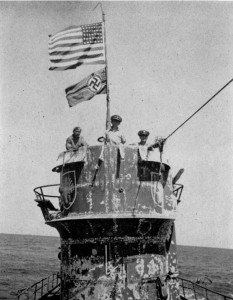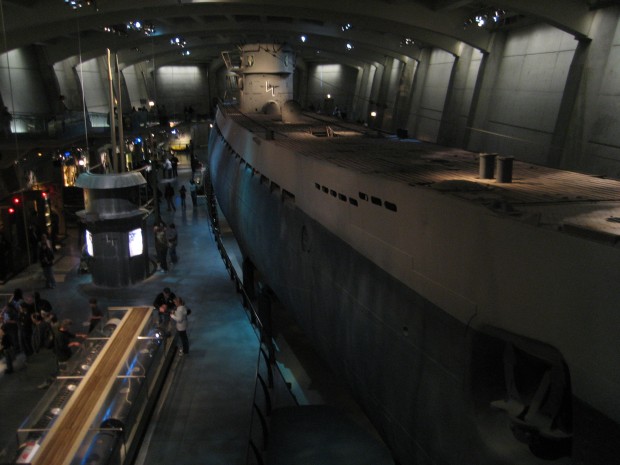US Vet Recalls U-Boat Brought To Bermuda
 A Washington State war veteran initially thought he was hearing things when the captain of his aircraft carrier told the crew to board and capture a surfaced German submarine that was then secretly towed to Bermuda during World War Two.
A Washington State war veteran initially thought he was hearing things when the captain of his aircraft carrier told the crew to board and capture a surfaced German submarine that was then secretly towed to Bermuda during World War Two.
Don Baker, 87, an Aviation Boatswain’s Mate First Class serving on the USS “Guadalcanal”, now lives in East Wenatchee, Washington.
“But he often thinks back to June 4, 1944, when Capt. Daniel V. Gallery and his Navy Task Group forced the German U-505 to the surface, convinced them with gunfire to abandon ship, and then rushed aboard to prevent the German submarine from sinking,” a Washington newspaper reports today [Nov. 11].
Mr. Baker said in then interview: “There were so many things that could have prevented it. It was like it was really intended to happen …”
He was just 17 when he joined the US Navy in June, 1942, six months after the attack on Pearl Harbor.
Two years later, he found himself on an aircraft carrier in the Atlantic Ocean, a member of the Navy Task Group 22.3, commanded by Capt. Gallery. The group included escort destroyers and a fleet of planes. Their mission was to find and sink enemy submarines.
In their first six months, they searched out and sank three U-boats on cruises to and from Norfolk, Virginia and Casablanca, Moracco, on the west coast of Africa.
They were about 200 miles from Africa on their second trip to Casablanca when they received intelligence of a German submarine in their area, Mr. Baker said.
But after days of searching day and night, they were almost out of fuel, so they gave up and were headed back toward Casablanca.
“I went back up on the flight deck, and I got there just in time to see the USS ‘Chatelain’ come running in at high speed,” he said. With two fighters circling overhead, he thought they were readying to land the aircraft, and the destroyer was taking up the plane guard position, in case a plane went off the carrier during landing.
Capture of the U-505, Part One
That’s when the shooting started. The USS “Chatelain” launched a “hedgehog attack,” — a series of mortars shot into the water that don’t explode until they make contact — followed by 16 depth charges.
“The whole ocean erupted,” Mr. Baker recalled. “I’d say we were about a quarter- to a half-mile away. And when the shock waves hit the ship, it was just like somebody was hitting it with a sledgehammer. I can only imagine what it was like for the Germans.”
When the German submarine U-505 surfaced, they came up shooting.
The Americans returned fire, using nothing that would penetrate the hull of the submarine.
Soon, the German captain told his men to abandon ship.
“When that was seen, the order was given to cease fire. And that was followed by an order that hadn’t been heard since 1815,” Mr. Baker said.
The order was “Away boarders!” as Capt. Gallery sent his men to board the submarine.
War had changed so much, it had been almost 130 years since the US had captured an enemy ship with plans to board it, he explained.
Mr. Baker described the many obstacles they overcame over the following hours and days to keep the U-505 afloat and to tow it to Bermuda in secret so the Germans wouldn’t know it had been captured.
There were problems pumping water out of the sub, a towing cable broke, and the sub’s rudder was jammed, forcing the submarine to one side and preventing it from being pulled easily through the water.
Capture of the U-505, Part Two
“The captain had a real prize on his hands if we could keep it from sinking,” he said. Eventually, they made it to Bermuda without being spotted, and with all of the Germans as their Prisoners of War, except one who died during the attack.
But the biggest prize of all were the code books and what’s known as the Enigma Machine, a device used for receiving and transmitting messages. They were used through the rest of the war to intercept German messages and locate and sink submarines.
The submarine remained in Bermuda’s Great Sound, shrouded in secrecy, for the remainder of the war.
It was moved to the US at the end of hostilities and is now exhibited in Chicago.
“Everybody was busting their buttons,” Mr. Baker recalled. “I can’t say that nobody ever talked. There’s no way to know that. But the secret was kept, and the Germans never learned that the U-505 had been caught.”
After the war, the news was released and the German POWs — whose families thought they had perished at sea – were repatriated to their native country.
An exhibit telling the remarkable story of the capture of the German U-505 and the subsequent decision to hide it on the island is the subject of a permanent display at the Bermuda Martime Museum’s US Navy Room at Commissioner’s House.
The U-505 now sits in a $30 million climate-controlled building at the Chicago Museum of Science and Industry [pictured below]. Mr. Baker sometimes goes there for a reunion of the Navy Task Group 22.3 Association, along with some of the German sailors who they pulled from the sea some 67 years ago.



What a GREAT story!!! Thank You BerNews!!!
Wow what a story ! Can anybody recognize the bay in the video where the sub is being towed to?
I am pretty certain that a crusty old St Davids island fisherman raised the alarm.
He had seen their periscope just above water and high tailed it back to land. Someone from St. David’s can confirm this!! He had to keep the secret too!
… I have just checked with family and I have mixed up this story with the discovery of a Life Boat which had a German Crew off St. David’s who’s captain was named John Ralph. They had been adrift for about 13 days or so. In fact he was given the life boat for one shilling. He named the boat John Ralph… my family enjoyed many a fishing trip in this boat… the St. David’s Island was named Gilbert Lamb, of Vaughn Bay, Cassia City St. David’s.
@ ‘History!!! one of my earliest memories is fishing on uncle Gilbert’s boat but the crew where Canadian Merchant Seamen and not German. The Helen Forsey was a Canadian Schooner. The crew had to take to the life boat after a Uboat – U514 surfaced and started to fire on them with it’s deck gun. Some of the crew didn’t make it off of her but those that did rowed/drifted 300 miles to Bermuda.
Uncle Gilbert was heading out fishing one day and spotted the boat and the crewmen waving at him so he went over and towed them in. As you say he was ‘sold’ the lifeboat for a nominal fee as they couldn’t give it to him outright. I can still remember the framed certificate that hung in his bedroom which was given to him by the Admiralty I believe.
The John Ralph had a distinguished career as a fishing boat used at times by my father.
@ Cybercop… they bay was the Great Sound, off NOB and the Dockyard area, it is mentioned in the body of the story. The sub was disguised in order to keep it a secret.
I have read and still have this book, as a matter of fact I have just re-read it. It’s called ‘Clear the Decks’ an excellent read. This story is testimony to proper preparation as Adm. Gallery had made it a feature to train his carrier group for just this sort of scenario. The Guadalcanal was a ‘Jeep’ Carrier who’s role was anti submarine warfare.
The Group arrived in Bermuda waters after dark but due to the wartime black out was unable enter harbour, this meant that the had to wait at sea until morning. This obviously caused some frustration and consternation as there was a real fear was that another Uboat could have spotted them and may have attempted to sink U-505 and also alert the Kriegsmarine that one of their Uboats had been captured thus causing them to change their codes. This would have been catastrophic and even though the Allies had already captured an enigma machine when HMS Bulldog sunk and captured U110 in May 1941.
The Bermuda pilot who guided them in knew it was a German Uboat the minute he saw it despite the attempted camouflage and is remembered as saying that he felt like running the &*%@$ aground!! All involved where of course sworn to secrecy but he did speak about it after the war.
I have read and still have Adm. Gallery’s book, It’s called ‘Clear the Decks’ an excellent read. This story is testimony to proper preparation as Adm. Gallery had made it a feature to train his carrier group for just this sort of scenario. The Guadalcanal was a ‘Jeep’ Carrier who’s role was anti submarine warfare.
The Group arrived in Bermuda waters after dark but due to the wartime black out was unable enter harbour, this meant that the had to wait at sea until morning. This obviously caused some frustration and consternation as there was a real fear was that another Uboat could have spotted them and may have attempted to sink U-505 and also alert the Kriegsmarine that one of their Uboats had been captured thus causing them to change their codes. This would have been catastrophic and even though the Allies had already captured an enigma machine when HMS Bulldog sunk and captured U110 in May 1941.
The Bermuda pilot who guided them in knew it was a German Uboat the minute he saw it despite the attempted camouflage and is remembered as saying that he felt like running the &*%@$ aground!! All involved where of course sworn to secrecy but he did speak about it after the war.